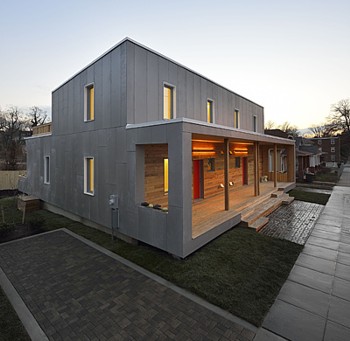Residents Move Into First Net-Zero Energy Home Built At Affordable Price in Washington, D.C.
 March 12, 2013
March 12, 2013  Kyriaki (Sandy) Venetis
Kyriaki (Sandy) Venetis In one of the first real-world examples of taking a green sustainable building design and using it to build a house that’s both energy eff icient and affordable, the creators of Empowerhouse have succeeded in doing exactly that.
 Empowerhouse. Photo courtesy of the Parsons New School For Design.
Empowerhouse. Photo courtesy of the Parsons New School For Design.
Empowerhouse is a two-family duplex, net-zero energy passive house originally built as part of the 2011 U.S. Department of Energy Solar Decathlon. Earlier this year, it became the new home of Lakiya Culley, a single mother of three, who works as a secretary for the U.S. State Department, and another family that will be transitioning out of public housing.
The Solar Decathlon is a biannual, international competition that challenges collage teams from around the world to design, build, and operate solar-powered houses, which are then exhibited on the National Mall in Washington, D.C. in September and October.
This house has two major components that need a little explaining. A net-zero energy house “produces as much energy as it consumes over the course of a year,” according to the U.S. Energy Department
The non-profit organization Passive House Institute US explains that a “passive house is a very well-insulated, virtually air-tight building that is primarily heated by passive solar gain” and a small internal heat source. It also has a constant supply of fresh air provided through “an energy recovery ventilator.”
Both experts at the Passive House Institute and the Parsons New School For Design (one of the primary participants in planning, design, and construction of Empowerhouse) agree that a passive house consumes up to 90 percent less energy for heating and cooling than a typical house.
This is the first passive house in the District of Columbia and has already received the Mayor’s Sustainability Award.
The house was developed in partnership with Habitat For Humanity of Washington, D.C., and the D.C. Department of Housing and Community Development. At the competition, it won the Decathlon’s first Affordability contest.
As part of the building process, the D.C. Department of Housing and Community Development said that the house features a panelization system that makes it easy for construction by volunteers, which includes many “off-the-shelf components that are available in home improvement stores.”
The New School For Public Engagement, a division of the Parsons New School, added that, “The design dramatically minimized the house’s expenses. Empowerhouse cost only $240,000; in contrast, the previous Solar Decathlon winner came in at about $800,000.”
As part of the project, D.C. Habitat for Humanity incorporated the financial design model of the Milano School of International Affairs, Management, and Urban Policy (which also participated in the project), making the “home more affordable for Habitat homeowners.”
The Parsons New School said that, “After the competition, while the other participating schools were dismantling their houses, the Empowerhouse team was gearing up to give their house a second life. The project was intended from the start to have a broader impact, serving as a real home for local families and as a model for affordable housing.”
At the conclusion of the Decathlon, Empowerhouse was moved to Deanwood, which is primarily a working-class, African-American community.
The area was selected because Deanwood is considered one of the greenest wards in Washington, D.C., with a history of community activism and self-sufficiency. Residents recently participated in the CarbonFree DC Extreme Green Neighborhood Makeover, which retrofitted low and moderate income homes.
Building on this theme of self-sufficiency and sustainability, Empowerhouse was also designed with a comprehensive water strategy that includes a rainwater harvesting system that captures and stores rainwater from both the property and the surrounding homes for use in the garden. The ultimate goal is to minimize water runoff going into the public sewer system.
The project also worked with Deanwood’s Lederer Community Youth Garden to provide plantings for a roof garden and vegetable boxes to provide the families with the opportunity to grow their own food.
The land for the house was donated by the D.C. Department of Housing and Community Development, which through its property acquisition and disposition division, donated three vacant lots for the project.
Since the house has been a community driven effort, the project has extended to creating workshops to educate local residents on how to make their homes more sustainable – from retrofitting solar panels to community gardening. The project has also created a new learning garden in Deanwood, working with Groundwork Anacostia and local volunteers.
The Empowerhouse project has been so successful that D.C. Habitat for Humanity has also broken ground on six new energy efficient town homes in the Ivy City community of northwest Washington, D.C., using Empowerhouse’s passive house design standard. They will become homes to low income families in the community.
Reader comments and input are always welcomed!

Reader Comments